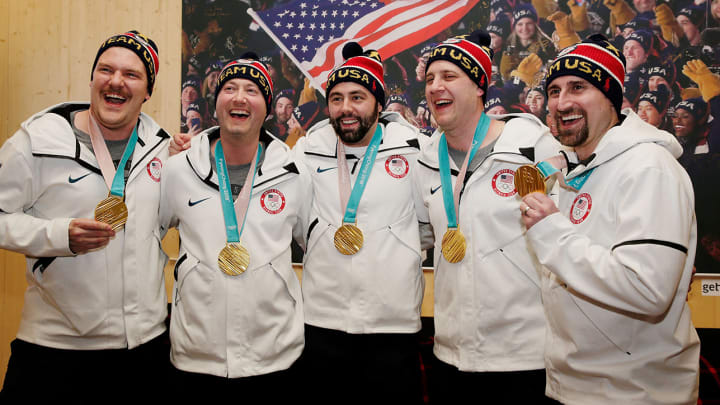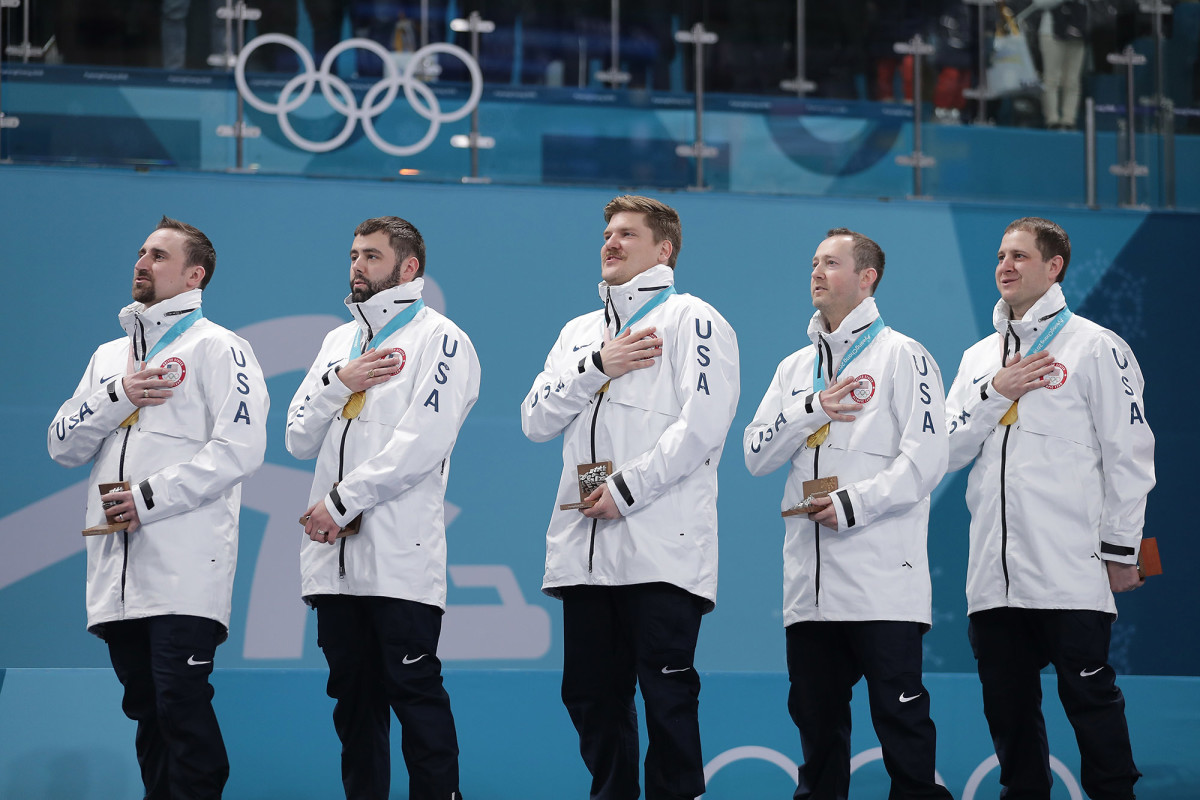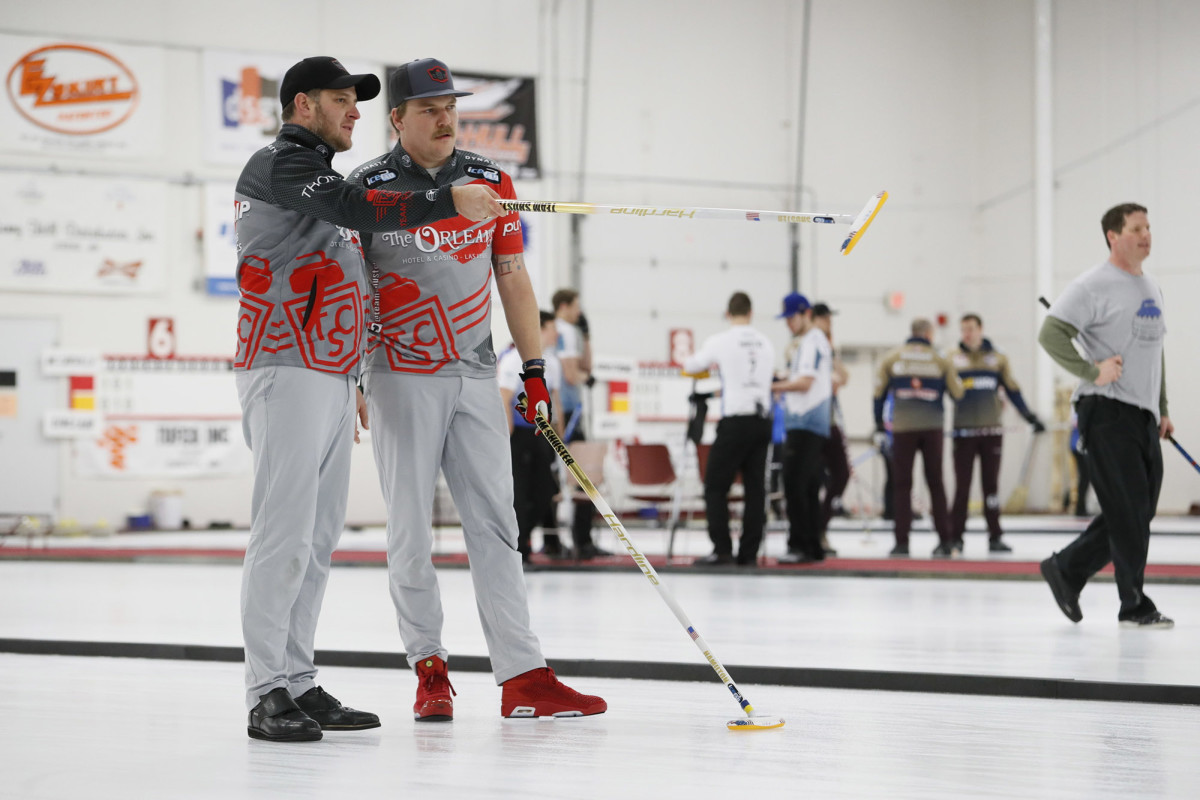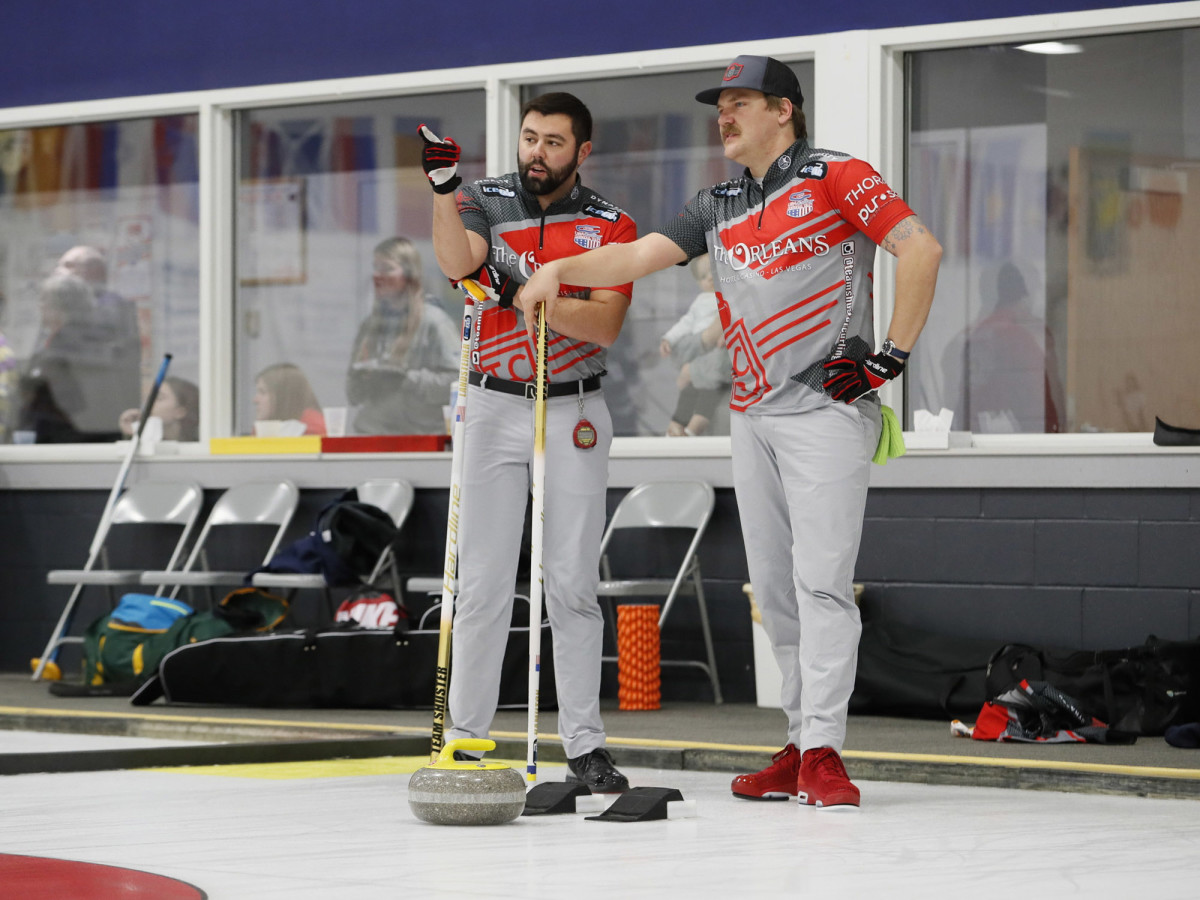How an Improbable Gold Medal at the 2018 Olympics Changed the Lives of the U.S. Men's Curling Team

This story appears in the Dec. 17-24, 2018, issue of Sports Illustrated. For more great storytelling and in-depth analysis, subscribe to the magazine—and get up to 94% off the cover price. Click here for more.
As the part-time sporting goods salesman sized up the shot that could seal the most improbable Olympic gold medal in curling history, the home appliance R&D technician swept at an imaginary piece of schmutz on the ice to give his teammate time to think. At the other end of the sheet, the liquor store owner used his broom to offer a target, while the corrosion engineer (yeah, we're not sure, either) stood by, ready to sweep.
Off to the side, the best curler in the world leaned on his broom, distraught over the errant shot that left him powerless to do anything but watch and hope that once again, John Shuster would falter in the Olympics.
He didn't.
Shuster perfectly executed a double takeout, clearing the two red Swedish stones out of the house and leaving behind five yellow rocks. A 5–5 tie was now a 10–5 U.S. lead with just two ends left. Had it not been the Olympics, Swedish skip Niklas Edin likely would have called the match on the spot. As it was, they played one more frame before Edin conceded, and Team Shuster officially became gold medalists—and the most celebrated group of American athletes to emerge from PyeongChang.

A victory like that can have a profound effect on even the most focused, built-in-a-lab athlete, let alone three Minnesotans and a Wisconsinite who look as if they stress over TPS reports and who say things like, "If I don't have pizza three or four times a week, I'm not happy"—an actual Shuster quote.
That's not to say that Shuster, Tyler George (the liquor purveyor), Matt Hamilton (R&D) and John Landsteiner (corrosion engineer?) are not to be taken seriously. Their sport, the butt of so many quadrennial jokes, is a lot more difficult than it looks and to master it requires not just agility and touch but also the ability to see things long before they develop. "It's a cerebral game unlike any other pro sport," says George. "You're always playing six, seven, eight shots ahead. Take your chessboard and make it 100 feet long and put it on ice."
But don't take his word for it. "Curling is not as easy as it looks," tweeted Mr. T, who helped popularize the hashtag #curlingiscoolfool during the Games. T's is not the only case of curling fever. Retired NFL defensive end Jared Allen took up the game nine months ago with an eye toward the 2022 Olympics. (The future Hall of Famer competed against Team Shuster in a bonspiel in Eveleth, Minn., in late November. Team Allen, which included former NFL quarterback Marc Bulger and two elite curlers, John Benton and Hunter Clawson, got shellacked.) As part of his bachelor-party festivities, Jordan Spieth took a group that included Rickie Fowler and Justin Thomas to the Dallas/Fort Worth Curling Club. Across the country, clubs are overbooked, forcing them to turn away newcomers. Curling Night in America is an actual thing on the NBC Sports Network, and ratings are up 36% over last year.
As for the golden boys, they've been everywhere, spreading their sport's gospel. They've been on The Tonight Show and Today. They've blown the horn before a Vikings game, thrown out the first pitch at the Twins' home opener and dropped the puck at an outdoor NHL game. They have their own tabletop curling game.
They're trying to not let the attention change them, but the experience has been life-altering. "I think I've only had four weeks where I worked 40 hours or more, which is insane," says Landsteiner, 28. "I'm starting to feel like I'm losing touch with my work reality compared to this curling reality," says Hamilton, 29. George, 36, is rarely at the liquor store now that he has retired from competition to become an ambassador for USA Curling. And Shuster is often out giving talks to businesses.
The story he has to tell is pretty compelling.
John Shuster is arguably the greatest curler in U.S. history. He played on the 2006 team that won bronze in Torino, then skipped—or captained—the '10 and '14 squads. The U.S. went a combined 4–14, and his surname became an unfortunate verb on urbandictionary.com. ("[T]o fail to meet expectations...")

After the dismal performance in Sochi, USA Curling held a combine to identify 10 athletes who would take part in its new high-performance program. Hopefuls were graded on their ice skills (throwing and sweeping), as well as being subjected to NFL-combine-style drills, such as shuttle runs and broad jumps. "Some of the guys didn't quite take it seriously," says 2018 Olympic coach Phill Drobnick. "I think they thought they were going to walk in and just be picked."
Motivated to prove USA Curling wrong, Shuster put together his own team, but he could pick only from curlers who weren't in the high-performance program. Hamilton had been cut from the combine. Landsteiner probably would have made it, but he scuttled his chances by admitting that he wasn't sure he wanted to commit the time and energy. George, who was pretty sure he was done curling competitively, hadn't even attended. Shuster persuaded them to join up. They called themselves Team Rejects.
Being outside the system wasn't a negative for Shuster, 36, who has always done things his own way. He was the rare high school pitcher who threw a knuckleball. He was good enough to play at Hibbing (Minn.) Community College, where his pitching coach insisted on the traditional strategy of busting hitters inside with a fastball. So Shuster dropped his subpar heater from his arsenal and became a full-on knuckleballer, so devoted to the pitch that he says the biggest thrill of his whole post-Olympic whirlwind was meeting Tim Wakefield—who greeted him with "Skipper!"—at a golf tournament. The two then played catch at the stadium of the Red Sox' Double A affiliate. ("My knuckleball is almost as good as his," Shuster says.) "I love pitching and having the control, and that's why I think I ended up being a skip," he says.
By picking his own team instead of being assigned to one by USA Curling, Shuster was able to find personalities that meshed. Landsteiner is the introvert; Hamilton's oversized personality and facial hair (Nick Offerman tweeted his interest in playing him in a Miracurl on Ice movie) make him the team's designated fun guy. Shuster, a self-described "flat-out crier," can get fiery, while George, a former skip who lost to Shuster in the finals of the 2010 Olympic trials, is a steely tactician.
Their balance served them well. They won the 2015 nationals, which got them invited to the high-performance program. A win at the Olympic trials in November '17 punched their ticket to South Korea, where, for Shuster, things took a frustratingly familiar turn. The U.S. started the 10-team round-robin with four losses in six games. As the skip, Shuster not only decides the team's strategy, but he also throws the final two rocks of each end—the crucial ones that determine the result. Stone after stone missed its mark.
The nadir came on Feb. 18, when the U.S. got crushed 8–2 by Japan in the morning and 8–5 by Norway that night. "We know how good John can be," says Hamilton. "He just hadn't quite clicked yet, and we knew that he was doing everything he could to have that aha moment, and we were confident he was going to find it eventually."

After the Norway match, while the other players snuck over to the 7-Eleven to get a beer, Shuster walked his wife, Sara, and their two kids to their bus. He then walked back to the venue by himself. "I just remember standing there and saying, 'You know what, I'm going to give my kids three games because we have three games left in the round-robin,'" he says. "Three games where they could take video so they could show their kids or their grandkids their dad at the Olympics, doing what he worked his whole life for." That meant remaining level. "I had to detach. I was very emotional about the results, but I had to be unemotional about the game."
Shuster wasn't noticeably different; he didn't broadcast his revelation. "I don't think he wanted to put that kind of pressure on himself," says Hamilton with a laugh. "Like, I think I had an aha moment. And then you go out there and s--- your pants and it's like, 'No, no, you didn't.'"
Shuster's trousers stayed pristine. The day after the Norway loss, the U.S. beat Canada for the first time in any Olympics. Wins over Switzerland and Great Britain meant the U.S. finished the round-robin at 5–4, good enough for a berth in the semis. A second victory over Canada put them through to the gold medal match. After a pregame pep talk over the phone from Mr. T, Team Shuster took the ice and matched the favored Swedes shot for shot.
The score was tied in the eighth end, but the Americans had the hammer (meaning they would throw the last stone). On his final shot Edin tried to bang his stone off a U.S. rock and then have it roll behind another yellow stone, where it would have been difficult to hit. Instead, he left it unprotected, meaning that Shuster could use his last shot to take out both Swedish stones. At the Duluth Curling Club, Shuster makes that shot 80% to 90% of the time. With a gold medal on the line, though, odds lengthen. Rarely is a chance for redemption so neatly packaged. After Hamilton finished cleaning the ice of nonexistent debris, he watched his skip start his slide down the ice. "I saw it [leave his hand]," says Hamilton, "and I was like, Game over."
And it was. But something else—something that will impact the lives of a group of Rejects for the rest of their lives—was just beginning.
